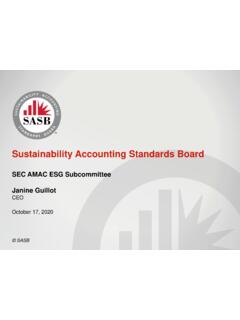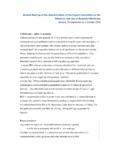Transcription of Session 11. Drug Use Evaluation - World Health …
1 drug and Therapeutics Committee Training Course Session 11. drug Use Evaluation Participants Guide drug and Therapeutics Committee Participants Guide iiThis document was made possible through support provided by the Agency for International Development, under the terms of cooperative agreement number HRN-A-00-00-00016-00. The opinions expressed herein are those of the author(s) and do not necessarily reflect the views of the Agency for International Development. About RPM Plus RPM Plus works in more than 20 developing and transitional countries to provide technical assistance to strengthen pharmaceutical and Health commodity management systems. The program offers technical guidance and assists in strategy development and program implementation both in improving the availability of Health commodities pharmaceuticals, vaccines, supplies, and basic medical equipment of assured quality for maternal and child Health , HIV/AIDS, infectious diseases, and family planning, and in promoting the appropriate use of Health commodities in the public and private sectors.
2 Recommended Citation The materials may be freely abstracted, quoted and translated in part or in whole by non-profit or educational organizations (for reference or teaching only) provided the original source is acknowledged. They should not be sold nor used for any other commercial purpose. Management Sciences for Health and World Health Organization. 2007. drug and Therapeutics Committee Training Course. Submitted to the Agency for International Development by the Rational Pharmaceutical Management Plus Program. Arlington, VA: Management Sciences for Health . Rational Pharmaceutical Management Plus Center for Pharmaceutical Management Management Sciences for Health 4301 North Fairfax Drive Arlington, VA 22203 USA Phone: Fax: E-mail: Web: Developed in Collaboration with the World Health Organization Geneva, Switzerland iiiABBREVIATIONS AND ACRONYMS ADR adverse drug reaction AMR antimicrobial resistance bid bis in die (twice a day) CrCl creatinine clearance DTC drug and Therapeutics Committee DUE drug use Evaluation DUR drug use review (per CPM word list)
3 GI gastrointestinal h hour IM intramuscular iv or IV intravenous kg kilogram mg milligram ml milliliter MSH Management Sciences for Health MUR medicine use review NSAID non-steroidal anti-inflammatory drug po per os (by mouth) q quart STG standard treatment guideline UTI urinary tract infection VA visual aid VEN vital, essential, nonessential WHO World Health Organization drug and Therapeutics Committee Participants Guide iv vCONTENTS Session 11.
4 drug Use Evaluation ..1 Purpose and Content ..1 Objectives .. 1 Preparation and Materials .. 1 Key Definition ..1 Introduction ..1 The Need for DUE ..2 A Stepwise Approach to DUEs ..3 Step 1. Establish Responsibility .. 3 Step 2. Develop Scope of Activities .. 4 Steps 3 and 4. Establish Criteria, Define and Establish Thresholds .. 4 Step 5. Collect Data and Organize Results.. 7 Step 6. Analyze Data .. 8 Step 7. Develop Recommendations and Action Plan .. 8 Step 8. Conduct DUE Follow-up .. 9 When DUEs Go Wrong ..9 Activity 1. Developing a DUE ..11 Summary ..11 Annex 1. Example of Established DUE Criteria on Data Collection Form for Amikacin ..12 drug and Therapeutics Committee Participants Guide vi 1 Session 11. drug USE Evaluation Purpose and Content Session 11 provides information on the concept of drug use Evaluation (DUE), a quality assurance method that is used worldwide, especially in North America and Europe, and that has been shown to be effective in identifying medicine use problems and as a method to improve medicine use.
5 A broad-based, ongoing, systematic DUE program is valuable in promoting and improving rational use of medicines in hospitals and clinics. Objectives After attending this Session , participants will be able to Understand the concept of DUE Understand the process for implementing and performing a DUE Discuss the use of a DUE for improving pharmaceutical therapy Prepare criteria and thresholds for a DUE Preparation and Materials Read the following Participants Guide Management Sciences for Health (MSH). 1997. Guidelines for Implementing drug Use Review Programs in Hospitals. Arlington, VA: MSH. American Society of Hospital Pharmacists. 1998. ASHP Guidelines on Medication Use Evaluation . Bethesda, MD: ASHP. Key Definition drug use Evaluation (DUE) An ongoing, systematic, criteria-based program of medicine evaluations that will help ensure appropriate medicine use.
6 If therapy is determined to be inappropriate, interventions with providers or patients will be necessary to optimize pharmaceutical therapy. This terminology is similar to that drug use review (DUR) and medication use review (MUR). Introduction The drug and Therapeutics Committee (DTC) is responsible for many important pharmaceutical management activities; two of the most important ones are identifying medicine use problems drug and Therapeutics Committee Participants Guide 2and implementing strategies to alleviate these problems. All DTCs should be actively involved in the Evaluation and selection of new medicines for the formulary and the provision of these medicines to practitioners. It must also ensure that these medicines are being used correctly so that patients receive the maximum benefit from their pharmaceutical therapy. Many strategies can be implemented to improve medicine use including educational programs, standard treatment guidelines (STGs) and other managerial activities, and regulatory programs.
7 Session 11 provides participants with more in-depth information concerning the important managerial strategy of DUE. A DUE will Define appropriate medicine use (by establishing approved criteria) Audit criteria against what is being prescribed Provide feedback to prescribers on all identified problems Monitor to see if criteria are followed and prescribing is improved The Need for DUE Irrational medicine use has occurred for as long as medicines have been available. In treating patients with modern medicines, several choices of therapy are available rather than just one that all providers must follow. This increased number of medicines and treatment options serves to increase the number of irrational medicine treatment encounters and, ultimately, poor patient outcomes. Casual observation, as well as more systematic study of prescribing practices, frequently reveals a pattern of diversity among prescribers in the treatment of even the most common conditions.
8 Polypharmacy is one problem; providers may use three, four, five, and sometimes more medicines to treat the most trivial conditions for the sake of satisfying a patient s need to receive medicines (or the pharmaceutical seller s need for profit). Other reasons for polypharmacy include lack of diagnostic competence or confidence and an inadequate knowledge of treatment regimens. Other common medicine use problems are choosing incorrect medicines, prescribing the incorrect dose, prescribing medicines that cause adverse drug reactions (ADRs) or medicine interactions, and using more expensive medicines when less expensive medicines would be equally or more effective. Other medicine use problems that suggest a need for DUE include the following Problems indicated from World Health Organization (WHO)/Management Sciences for Health (MSH) indicator studies High number of ADRs Signs of treatment failures Excessive number of nonformulary medications used Session 11.
9 drug Use Evaluation 3 Use of high-cost medicines where less expensive alternatives exist Excessive number of medicines within a therapeutic category DUE, a system of improving the quality of medicine use in hospitals and clinics, is an ongoing, systematic, criteria-based program of medicine evaluations that will help ensure that appropriate medicine use is provided. A DUE can be structured so that it will assess the actual process of administering or dispensing a medicine ( , appropriate indications, dose, medicine interactions) or assess the outcomes ( , cured infections, decreased lipid levels.) Objectives of a DUE are as follows Ensuring that the pharmaceutical therapy meets current standards of care Promoting optimal medication therapy Preventing medication-related problems Identifying specific medicine use problems that require further Evaluation Creating guidelines (criteria) for appropriate medicine use Defining thresholds for quality of medicine use Enhancing accountability in the medicine use process Controlling pharmaceutical cost A DUE system can be established in a short period once it has become clear what medicine use problems exist.
10 Many of these problems can be identified from other DUE studies, a review of aggregate data in the hospital ( , most costly medicines, most prescribed medicines, ADR records), medical chart reviews, hospital and clinic medicine use indicators, or recommendations of DTC members. Regular meetings of the DTC and assessments of quality measurements in the Health care system should be able to identify problems that can be addressed in a DUE for resolution. A Stepwise Approach to DUEs The following eight steps outline the basic information necessary to start and maintain a DUE program. Step 1. Establish Responsibility Responsibility falls to the DTC or a subcommittee of the DTC that functions only to monitor DUEs in the hospital or clinic. The DTC should undertake this responsibility with considerable interest, because this process can solve many medicine use problems, as has proven to be the case in many countries where this quality assurance function has been fully utilized.
















